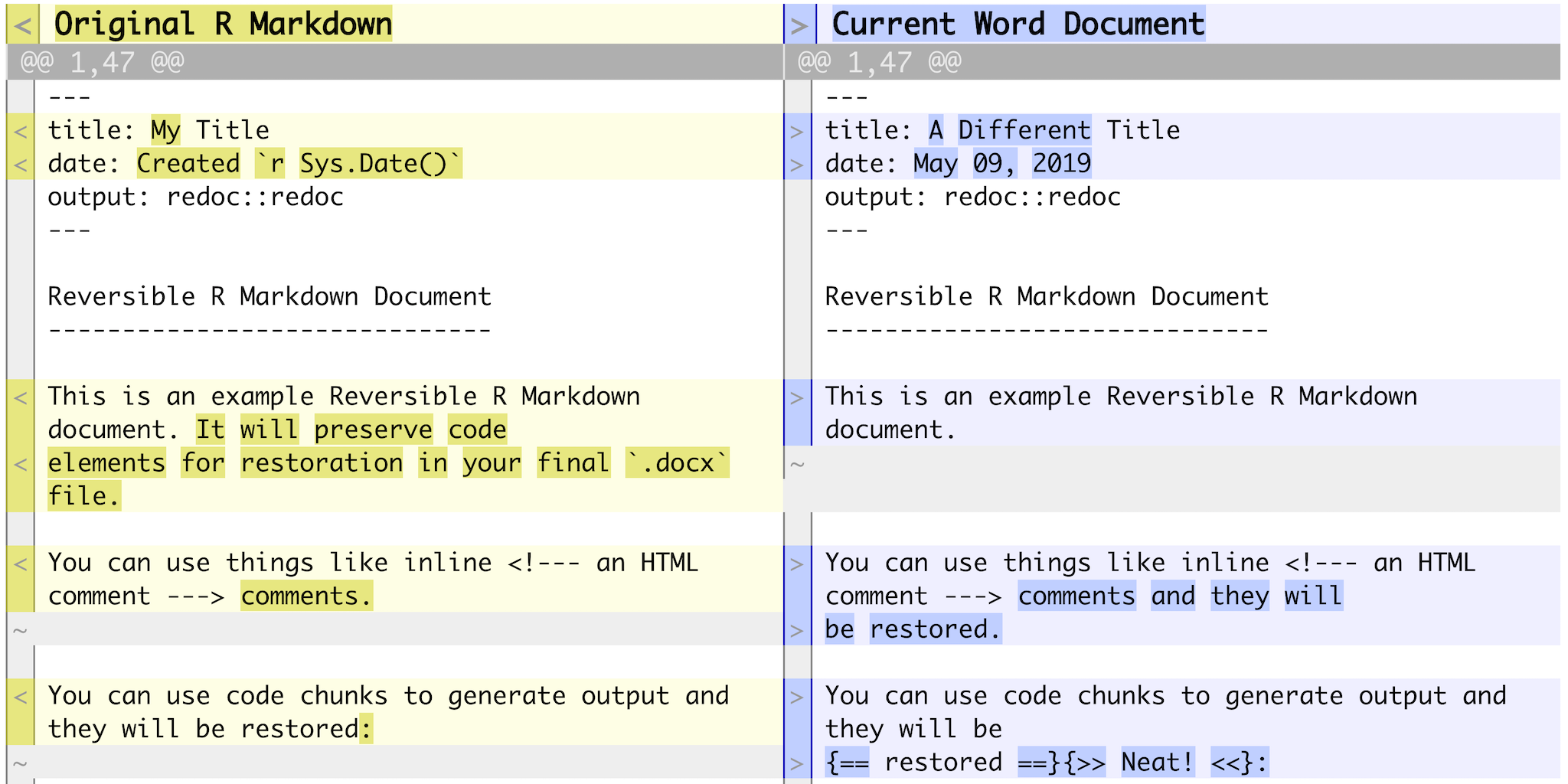Mixed Workflows with redoc
Source:vignettes/mixed-workflows-with-redoc.Rmd
mixed-workflows-with-redoc.Rmdredoc is a package to enable a two-way R Markdown-Microsoft Word workflow. It generates Word documents that can be de-rendered back into R Markdown, retaining edits on the Word document, including tracked changes.
Installation
Install the redoc package with the remotes (or devtools) package:
remotes::install_github("noamross/redoc")
Note that redoc requires a recent version of Pandoc (>= 2.1.2). If you have RStudio version 1.2 or higher, you should have this by default.
Basic Usage
redoc provides an R Markdown output format, redoc(), built on top of rmarkdown::word_document(). You will typically call it via the YAML header in your R Markdown document:
The simplest way to get a working YAML header (and example document) is to create a new R Markdown file from the template. To do this in RStudio, select File > New File > R Markdown…, then in the pop-up window select ‘From Template’ and Reversible Microsoft Word Document {redoc}. (Note that if you just installed the redoc package, you may have to restart RStudio for the template to appear.)
redoc() output resembles typical R Markdown Word output, but has some key differences:
- Critic Markup edits will be converted to Word tracked changes.
- By default, parts of the documented generated programmatically will be highlighted. (Change this with
highlight_outputs = TRUE) - The original
.Rmdand all code is stored internally in Word document for later retrieval.
Word files that have been created by redoc() can be reverted to .Rmd with the dedoc() function, even after they are edited. dedoc() will return the path of the de-rendered document.
library(redoc) print(basename(redoc_example_docx())) #> [1] "example.docx" dedoc(redoc_example_docx()) #> [1] "./example.Rmd"
If the Word document has tracked changes, dedoc() will, by default, convert these to back to Critic Markup syntax. However, tracked changes are not necessary. You can view the changes between the original R Markdown file and the de-rendered one using the redoc_diff() function.

Note that redoc tracks changes to parts of the document that are specified in the YAML header - title, subtitle, author, and date.
RStudio Integration
redoc has three RStudio Addins to simplify workflow when working with R Markdown documents:
- “Render and Update” renders an R Markdown Document and the updates the text after round-tripping in to Word format and back. This helps with cleaning up small syntax differences. YAML headers, for instance, will use single rather than double quotes, only quote when necessary, and use
yesandnoinstead ofTRUEandFALSE. Critic Markup annotations will be separated from adjacent text by a space. Lines will be wrapped to a uniform width. If you round-trip your document this way, you can minimize the changes that result from editing. If you don’t use the Addin, you can retrieve the round-tripped document withredoc_extract_rmd(..., type = 'roundtrip'). - “Dedoc to active file” and “Dedoc to new file” de-render a file and place the contents in RStudio editor tabs, and also display a diff changes in the RStudio viewer.
The package also contains a redoc R Markdown template.
Handling changes
redoc attempts to be smart about restoring code in Word documents that have been modified. By default, if the outputs of code blocks move, the code blocks will also move in the de-rendered R Markdown. Note that this can break code if blocks are moved out of order.
If code block outputs are deleted, the original code is restored, but wrapped in HTML comments (<!-- ... -->). Inline code that is deleted is not restored. Defaults of how code is restored can be modified via the block_missing and inline_missing arguments in dedoc().
You can also extract the original R Markdown file used to produce a Word document with redoc_extract_rmd().
Additional Features
The redoc() format has some additional arguments for formatting Word documents, margins and line_numbers. These can be set in the YAML header to modify your, er, margins and line numbering
---
output:
redoc::redoc:
margins: 0.5 #sets margins to 0.5 inches
line_numbers: TRUE # adds line numbers to the document
---These can also take more complex lists of values for finer control. These functions may be migrated to officedown at a future time.